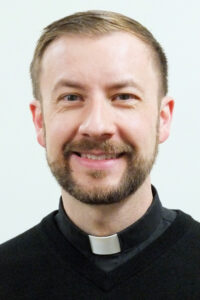By Father Thom Hennen
Question Box

What is the proper posture of our hands for the Our Father at Mass? What is the proper way to greet people during the sign of peace and how far down the pew should you go? What is the correct posture before entering the pew or passing in front of the altar or tabernacle?
I addressed the first question in an earlier column. Basically, there is no prescribed posture for one’s hands during the Lord’s Prayer. Some couples or families may choose to hold hands but this posture should not be imposed on anyone. It is perfectly acceptable to pray with your hands folded.
As for the sign of peace (technically, the “Rite of Peace”), it is interesting to observe the variety and duration of this gesture. I remember visiting my siblings’ parish, which was a predominantly African American Catholic community in St. Paul, Minnesota. The sign of peace probably took 15 minutes, as people went from pew to pew greeting each other warmly, hugging and shaking hands. While this expression is certainly in the spirit of the rite, it probably is not what the rubrics envision. Then again, there is a legitimate place for inculturation. In that parish it felt genuine and appropriate, not forced or schmaltzy.
On the other end of the spectrum, there is what I call the “pivot, nod and grunt” gesture, which hardly seems like a sign of peace. It reminds me of a joke some of my more rural Minnesota relatives told me: How can you tell if a Minnesotan is an extrovert? He’ll look at your shoes when he’s talking to you.
Even in places and parishes where people are more emotionally reserved, it seems appropriate to turn to those nearest you, make eye contact, smile and, while extending your hand, to say clearly, “Peace be with you.” If you are not feeling well or if its clear that someone around you does not wish to shake hands, then a smile and slight bow or nod while wishing them peace is still in order.
The General Instruction states: “As for the actual sign of peace to be given, the manner is to be established by the Conference of Bishops in accordance with the culture and customs of the peoples. However, it is appropriate that each person, in a sober manner, offer the sign of peace only to those who are nearest.” That would seem to rule out bear hugs and going up and down the aisles.
In regard to posture when entering the pew, if the tabernacle is in the sanctuary and clearly visible, it is appropriate to genuflect. However, if you are unable to genuflect, then a profound bow (from the waist) is the next best option. Similarly, this would be the case when passing by the tabernacle. Of course, do what your body will allow you to do. God knows your heart. When the tabernacle is not present in the sanctuary but in a separate chapel or on a side altar, then a profound bow is the more appropriate gesture when entering the pew. The same is true when simply passing by the altar.
What is the appropriate posture during eucharistic adoration?
Again, do what your body will allow you to do or what is most conducive to prayer. If you can kneel throughout, fine, but you are not a lesser Catholic if you need to sit or even stand (as long as it is not a distraction to others). When the Blessed Sacrament is exposed, the rite book regulating eucharistic exposition and adoration states that a single genuflection is sufficient.
(Father Thom Hennen serves as the pastor of Sacred Heart Cathedral in Davenport. Send questions to messenger@davenportdiocese.org)











